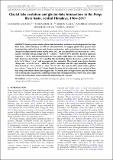Glacial lake evolution and glacier–lake interactions in the Poiqu River basin, central Himalaya, 1964–2017
Abstract
Despite previous studies, glacier–lake interactions and future lake development in the Poiqu River basin, central Himalaya, are still not well understood. We mapped glacial lakes, glaciers, their frontal positions and ice flow from optical remote sensing data, and calculated glacier surface elevation change from digital terrain models. During 1964–2017, the total glacial-lake area increased by ~110%. Glaciers retreated with an average rate of ~1.4 km2 a−1 between 1975 and 2015. Based on rapid area expansion (>150%), and information from previous studies, eight lakes were considered to be potentially dangerous glacial lakes. Corresponding lake-terminating glaciers showed an overall retreat of 6.0 ± 1.4 to 26.6 ± 1.1 m a−1 and accompanying lake expansion. The regional mean glacier elevation change was −0.39 ± 0.13 m a−1 while the glaciers associated with the eight potentially dangerous lakes lowered by −0.71 ± 0.05 m a−1 from 1974 to 2017. The mean ice flow speed of these glaciers was ~10 m a−1 from 2013 to 2017; about double the mean for the entire study area. Analysis of these data along with climate observations suggests that ice melting and calving processes play the dominant role in driving lake enlargement. Modelling of future lake development shows where new lakes might emerge and existing lakes could expand with projected glacial recession.
Citation
Zhang , G , Bolch , T , Allen , S , Linsbauer , A , Chen , W & Wang , W 2019 , ' Glacial lake evolution and glacier–lake interactions in the Poiqu River basin, central Himalaya, 1964–2017 ' , Journal of Glaciology , vol. First View . https://doi.org/10.1017/jog.2019.13
Publication
Journal of Glaciology
Status
Peer reviewed
ISSN
0022-1430Type
Journal article
Description
This study was supported by grants from the Natural Science Foundation of China (41871056, 21661132003, 41571068, 41571061 and 41771088), the Strategic Priority Research Program (A) of the Chinese Academy of Sciences (XDA20060201), the Swiss National Science Foundation (project: “Recent and future EVOlution of Glacial LAkes in China (EVOGLAC)”, IZLCZ2_169979/1) and the Dragon 4 project funded by ESA (4000121469/17/I-NB). G. Zhang thanks the China Scholarship Council for supporting his visit to University of Zurich from December 2017 to December 2018 (no. 201704910339). TanDEM-X CoSSC data were provided by German Aerospace Center (DLR) with proposal ATI_HYDR7290.Collections
Items in the St Andrews Research Repository are protected by copyright, with all rights reserved, unless otherwise indicated.

